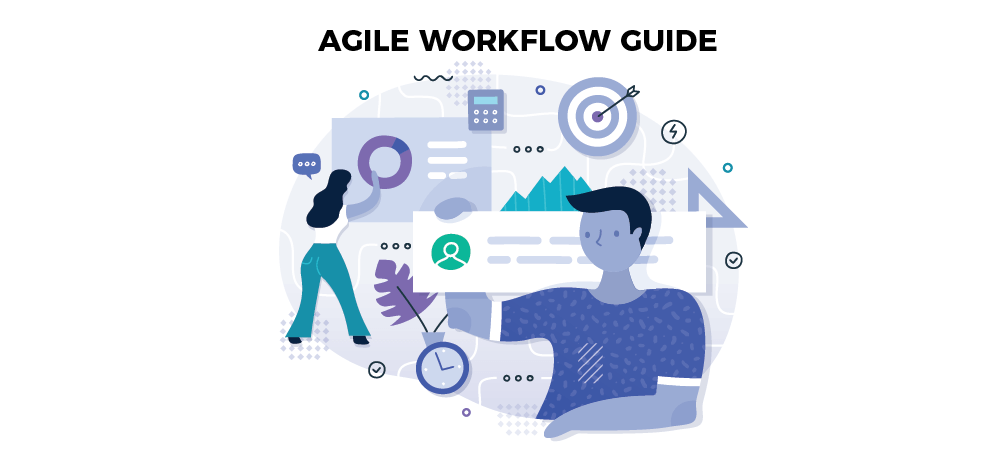With dozens and dozens of companies entering the market every year, one has to contemplate various project management processes that are best for tackling industry challenges.
Agile is the most popular approach in the project management paradigm so it’s quite obvious that most companies and their project managers want to know what the Agile workflow is.
In this article, we will let you know all about the Agile workflow and how you can successfully apply it to your project. Reading this, you will come to terms with everything from Agile development principles to the principles, using which you can increase the productivity of your business.
Let’s start at the very beginning.
Agile Methodology in Project Management
Agile is a marvelous project management methodology that immensely increases the success rate and the efficiency of a project. How? Well, it does that by using these steps:
- The first step it takes is that it breaks apart the project into smaller individual cycles which makes it easier for the team to deal with all of the components individually.
- The next step is to involve all of the relevant customers of the company, in the decision-making process. This will allow you to get important feedback from the customers regularly which you can then implement to produce the perfect product.
How is Agile Workflow different than the others?
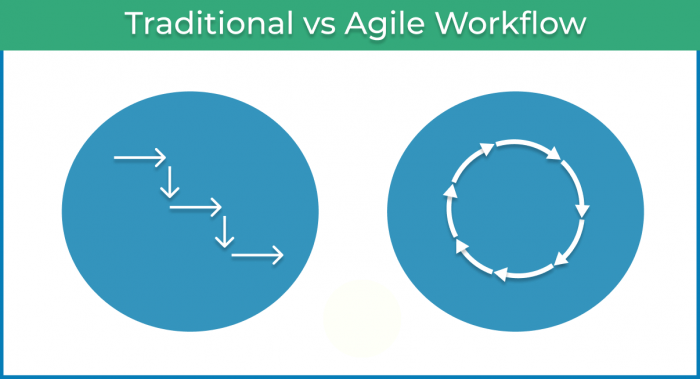
Well mostly in the organization paradigm, all of the project management methodologies that the managers only incorporate user feedback about the project, after the product has hit the market.
That’s why other methodologies like the Waterfall model are only capable of handling one big release in the time of six months or so.
While methodologies like the Waterfall method enable you and your team to work without any outside interruptions, it can decrease the effectiveness and the efficiency of the product before it even reaches the market, just because you didn’t test it first with your customers.
Agile processes, on the other hand, include customer engagement at every step. This helps them understand the product and let you know if something is not right with it which you can change.
Check out this practical guide for project management methodologies:
How to Use nTask for Waterfall Project Management
4 Key Elements of the Agile Methodology
Before we go into the details of the Agile workflow that goes behind the workings of the methodology, you need to understand some key terms that are an important part of the product development process.
A. 12 Key Principles of Agile Methodology
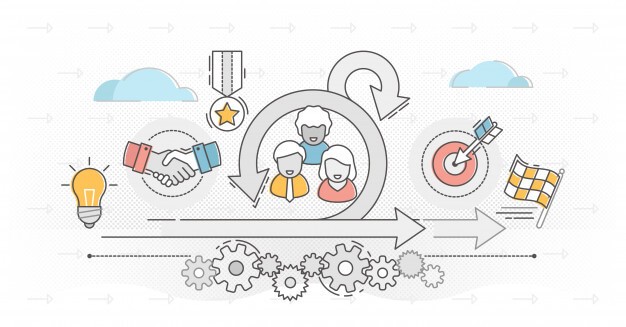
- Whenever the company is developing a product, they have to remember that customer satisfaction regarding the product is the top-most priority. To achieve this, you need to keep the customers in the loop and make changes accordingly.
- The managers and their team members need to understand that they have to be alert and open to embracing all of the requirements whether or not they are changing even if the product is at the very end of the development process.
- You need to make sure that the customers are presented with the working builds of the product whenever possible. This will help you get constant feedback from the end user and build the perfect project that the customers will love.
- In the Agile methodology, success is defined as a product that completely satisfies the needs and requirements of the customer.
- You need to understand that when you are creating your Agile workflow, you need to do it around some highly motivated and capable people. All you need to do then is to provide a productive and peaceful environment for them to spread their wings and give you the perfect project.
- You and your team have to perform at your highest when it comes to dedicating your time and expertise to create the most perfect product that fully satisfies the needs and requirements of the customer.
- All of the team members and the concerned stakeholders that are connected to the project have to be on the same page without any complications. This is important for a seamless progression of the product development process.
- All of your processes that rely on the tests being performed on different factors affecting the project, have to be quite sustainable. In addition to that, your Agile team must give their all while working to maintain the speed and quality of the work being done.
- One thing the managers need to understand is that when it comes to collaboration and communication with their troops, they need to make sure that it is face-to-face so that there are no blank spaces and everyone is on the same page as far as the development process goes.
- Looking at the stats gathered from the market, it seems that the teams that are better at self-organizing have the best chance of being successful and providing the perfect working software. This means that the status hierarchy is not something that needs to be nailed down during the development process and the team has to give the space to do their own thing.
- When it comes to projects that are being developed via the Agile methodology, you must make the process easier and easy to be implemented and for that, you need to eliminate all iterative procedures that are not necessary for the development process.
- The managers need to monitor and evaluate the performance and productivity of their troops at regular intervals. This helps them keep everyone in check and devise better and more productive strategies for future projects.
B. Product Backlog
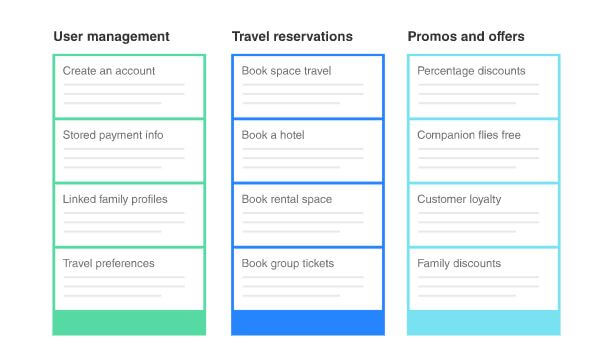
Whenever you are working via the Agile development methods, you need to start by creating your product backlog to fall back on. This backlog consists of all of the ideas and different tasks associated with the development process of the product.
When you start to create the backlog, it consists of all of the rough versions of ideas that the managers, stakeholders, and team member have brainstormed. Don’t worry, as you move along in the project development process, it will slowly start to take shape.
How will that happen?
Well, as you incorporate all of the customer feedback that you receive, you will get a sense of the direction that your project needs to take to be successful and be widely accepted by the customers. This is how the backlog grows and grows, as more feedback comes in and you make steady progress.
The items included in the product backlog need to be:
- Prioritized in such a way that when the team monitors it later, it needs to highlight all of the most important user stories gathered.
- Well-defined in a way that the development team can easily understand the reason why the feature being worked on is going to be highly beneficial for the user.
- Precise in a way that it ensures the duration and time frames of the tasks about to be performed and that they won’t waste any of the team’s or the company’s time.
C. Sprints
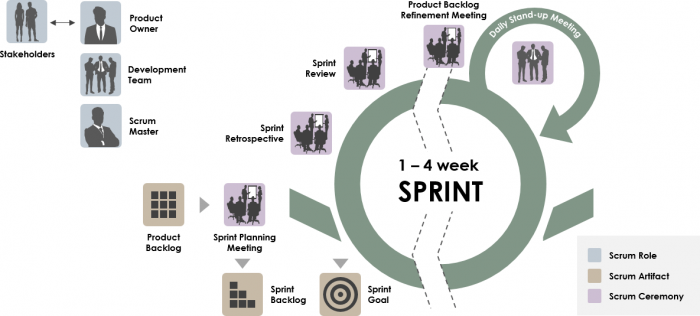
Sprints are the parts of the development cycle in which the team takes action on the items that were added to the product backlog.
They are small development cycles whose goals and objectives are set at the start, that are needed to be completed in a certain amount of time. They are mostly 7 or even 10 days long.
D. Agile Meetings
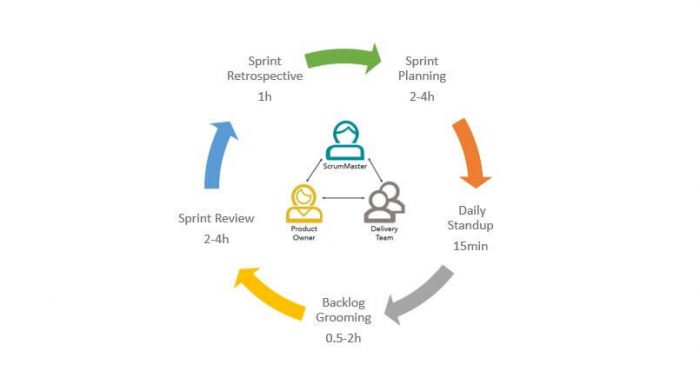
Source: Dzone
One thing that the managers need to make sure to do is to conduct regular meetings among the team, themselves, and the stakeholders. This will make sure that all of the entities associated with the project development process are well-informed and that there are no scope creeps or black spaces between them.
There are two kinds of meetings that take place in the Agile workflow:
- Daily Stand-ups
- Sprint Retrospectives
Agile Workflow Process
Now we will see what an Agile Workflow process looks like and how does it work?
As Agile methodology is used heavily in the software development processes, we will focus on that. However, the Agile workflow remains roughly the same no matter what type of project you’re working on.
How to optimize agile workflow?
Optimizing the efficiency of an agile workflow necessitates an unwavering commitment to constant progress and teamwork. To refine your agile workflow, consider employing the following strategies:
Define the workflow process:
Begin by pinpointing the primary objectives and prerequisites of the project, and subsequently establish a suitable workflow process.
This approach will ensure that team members have a comprehensive grasp of their roles and responsibilities, thereby fostering accountability and productivity.
Implement Agile tools:
Leverage cutting-edge Agile tools to streamline the workflow and bolster overall efficiency. Utilizing platforms such as Jira, Trello, and Asana enables teams to effectively manage tasks, monitor progress, and collaborate seamlessly.
Foster collaboration and communication:
Actively promote a culture of open communication and collaboration among team members. Regular engagement can be facilitated through daily stand-up meetings, sprint reviews, and retrospectives, which will serve to maintain focus and alignment on project goals.
Embrace Continuous Improvement:
A cornerstone of Agile methodology is the commitment to ongoing growth and development. As such, it is crucial to routinely assess the workflow process and pinpoint areas that warrant improvement.
By consistently refining methodologies and practices, teams can ensure that their agile workflow remains responsive and adaptable to evolving project needs.
Challenges a Project Managers face when managing an agile workflow
As a project manager, managing an agile workflow can pose several challenges. Here are some of the most common hurdles that project managers may face:
Lack of predictability:
Agile methodology involves iterative development, which can be unpredictable. This can make it difficult for project managers to estimate the timeline and budget accurately.
As a result, project managers must rely on their experience and expertise to stay on schedule and within budget.
Difficulty in managing change:
Agile methodology allows for changes to be made throughout the project lifecycle, based on feedback and insights gathered during the development process. However, this can be challenging for project managers, as it requires constant monitoring and adjustment.
Project managers must be able to manage changes effectively without compromising the project’s overall objectives.
Managing multiple projects:
Project managers who manage multiple agile projects simultaneously face the challenge of prioritizing tasks and managing resources effectively.
This requires a keen understanding of the project requirements and resource capabilities, as well as effective communication and collaboration with team members.
Balancing team autonomy and project goals:
Agile methodology emphasizes team autonomy, which can be challenging for project managers who need to balance the team’s autonomy with the overall project goals.
Project managers must be able to provide guidance and support to the team while allowing them the freedom to make decisions and work independently.
Ensuring stakeholder satisfaction:
In an agile workflow, stakeholder feedback is collected regularly throughout the development process. Project managers must ensure that stakeholders are satisfied with the progress and direction of the project.
This requires effective communication and collaboration with stakeholders, as well as the ability to address concerns and make necessary changes.
Types of Agile Workflows
Various Agile workflows have been developed to cater to different project needs, each with its distinct characteristics and approach. The following are some of the most commonly used Agile workflows:
Extreme Programming (XP): XP is a software development methodology that prioritizes high-quality code and customer satisfaction. It emphasizes teamwork, simplicity, and communication, utilizing techniques such as pair programming, test-driven development, and frequent integration.
Scrum: Scrum is a popular Agile framework that focuses on teamwork, communication, and incremental development. Key components of Scrum include daily stand-up meetings, sprint reviews, and retrospectives to ensure continuous improvement and adaptation.
Kanban: Kanban is a visual workflow management system that promotes continuous delivery and smooth flow of work. The core elements of Kanban include visualizing the workflow, limiting work in progress, and managing flow to improve efficiency and minimize bottlenecks.
Agile Unified Process (AUP): AUP is a streamlined version of the Unified Process (UP) that emphasizes agility and iterative development. It consists of four phases: inception, elaboration, construction, and transition, and employs practices from various Agile methodologies.
Feature-Driven Development (FDD): FDD is an Agile software development methodology that highlights domain modeling and feature-driven planning. It follows a five-phase process: domain walkthrough, development of an overall model, feature list creation, planning, and design and build iterations.
Crystal Methodology: Crystal Methodology is a family of Agile methodologies that place importance on communication and people-centric practices. It comprises seven color-coded methodologies, each tailored to different project sizes and complexities, focusing on lightweight processes and adaptability.
Lean Development: Lean Development is an Agile methodology inspired by Lean Manufacturing principles, emphasizing the elimination of waste and the delivery of value to customers. It promotes continuous improvement, efficient resource utilization, and the pursuit of perfection.
Agile Software Development Cycle
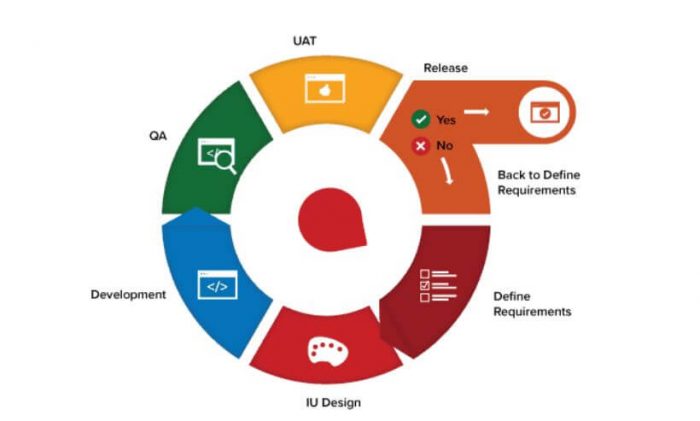
Source: Smartsheet.com
Here are some of the typical software development processes in the Agile methodology.
- Conception: This is the stage where the project you want to work on is envisioned by experts and all of the tasks and goals are planned. To put things into play, first, you make a product backlog consisting of every little brainstormed detail and then plan out the sprints.
- Inception: Now that everything has been envisioned and well thought out, you need to create specific teams that are needed to complete all of the required tasks in their respective sprints.
- Iteration: During this stage of the Agile software development cycle, the development team starts to work on the sprints assigned to them in the last step. This will enable you to tackle all of the items mentioned in the product backlog.
- Release: Once the work on the sprints has been completed, you need to make sure that the product at hand gets to the customer base as soon as possible. This will enable you to get their timely feedback and perform any changes that they deem necessary to make the product a hit.
- Retirement: This is the step where all work is ceased on the project and the manager puts an end to all Agile workflow activities, marking the end of the project development process.
How an Agile Workflow is Created?
There are 4 different steps that you can use to create your Agile workflow. They are:
1. Forming
The first step that your team needs to take is that they need to understand all of the principles regarding Agile. This will enable them to make their own decisions, as they move further in the development process, about choosing the perfect Agile practice for the situation they’re in.
While Forming, keep these three things in mind:
- Going over Agile events like daily stand-ups, sprint planning, and sprint retrospectives
- Implementing and understanding the Agile speciality roles
- Understanding the various Agile principles and the rationale behind implementing them
2. Storming
In this step, you start developing the required backlog consisting of all of your tasks and ideas brainstormed by your team and stakeholders. Furthermore, you need to divide all of these tasks from the backlogs into their respective sprints.
Involve your team in the process of forming sprints, because at the end of the day, they are the ones that have to execute them. This will make sure that all of the sprints that you create are realistic and no unnecessary demands are being asked to be completed in an unrealistic timeframe.
3. Norming
In this stage, you need to start defining the roles of all of the people involved in the project development process. You’ll have to work out what team members will be better suitable for what sprint so that the whole development process goes seamlessly without any interruption.
If you are working on an Agile project, you need to select a:
- Project manager
- Product owner
- Project Team
- Project Stakeholders
4. Performing
This is the stage where your team goes to work.
When they are doing so, they need to make sure to follow every principle of the Agile methodology that we have studied earlier so that there are no obstacles in the development process and there is a constant improvement linked with the whole process.
Once the team has completed their assigned work and you have a working software beta at hand, you need to make sure that the managers supply this beta to the customers for feedback generation. This enables you to get timely feedback from them and if there are any changes required, the team can work on them and make the product flawless.
One other thing to do is that you need to use the right set of tools when it comes to Agile workflow. Here are some of the features that an Agile workflow tool should have:
- Facilitate Team Collaboration
- Document the product backlog
- Plan all of the sprints
If you are not using a project management tool, try nTask which has all of these amazing features and a whole lot more where that came from.
What is Agile vs. traditional workflow?
Agile and traditional workflows are two different ways to organize, coordinate, and manage tasks within a project.
Traditional workflow is the traditional project management method that relies on planning and scheduling activities in advance to meet the project’s goals.
This means that tasks must be divided into stages; each stage has specific deadlines and objectives that must be met before moving on to the next stage.
Therefore, this system is well suited for projects with predefined parameters as it offers more control over how tasks are carried out and monitored.
Meanwhile, agile workflow is an iterative process centered around responding quickly to new information or changes during a project’s development.
It focuses heavily on collaboration between team members to refine ideas for improvement throughout all stages of a project’s progress—from concept ideation through completion—and encourages feedback frequently from stakeholders so that potential issues can be addressed quickly before they become problematic during later phases of development.
Thus, agile methodology facilitates experimentation alongside learning from any mistakes found along the way and immediate modifications if needed due to unforeseen circumstances or requirements that may arise throughout a given period or time frame of a project’s execution.
It’s important to note that while both systems have unique strengths when applied correctly, many organizations are finding success using hybrid approaches by incorporating elements of both frameworks depending on their particular needs and desired results.
This allows them to maintain some level of predictability while allowing room for creativity when needed. Something which might not always have been possible with more rigid forms of organization like traditional workflows exclusively implemented without fail.
In such cases, where innovation is welcomed with open arms, agile methods can address emerging challenges quicker than ever imagined possible until now, much less accomplished.
What are the advantages of Agile workflow?
Adopting an agile workflow has many advantages over traditional methods like a waterfall, including faster delivery times and better collaboration between teams resulting in higher quality products, delivered efficiently, on time, or even ahead of schedule, most of the time.
Through short iterations, commonly known as ‘sprints,’ and frequent stakeholder engagements throughout each cycle, stakeholders have continuous visibility into ongoing progress and consistent opportunities for giving feedback and influencing design decisions until product launch day.
Additionally, testing & debugging can be done ‘in parallel’ within each iteration, eliminating potential issues before they become costly nightmares later down the track.
An important benefit stemming from quicker release cycles via ‘agile’ lies within cost efficiencies which present themselves when working towards tight budgets & timelines.
Rather than aimlessly trying to tweak everything upfront before release and potentially running out of money & resources halfway through, breaking things down into smaller pieces allows clear objectives forming part milestone completion.
Allowing incremental investments while ensuring the team remains focused on what matters most, above all else, delivering value to end customers at every turn.
Long term, this philosophy encourages happy clients who keep coming back again, meaning stronger relationships overall.
Providing rewards both financially and economically, but also socially speaking, makes everyone involved feel good about hard-earned successes and rare gems life throws our way when you least expect them to.
Thus, making ‘agility king’ amongst age-old techniques long forgotten, at least here anyway.
Optimizing Agile workflow with nTask
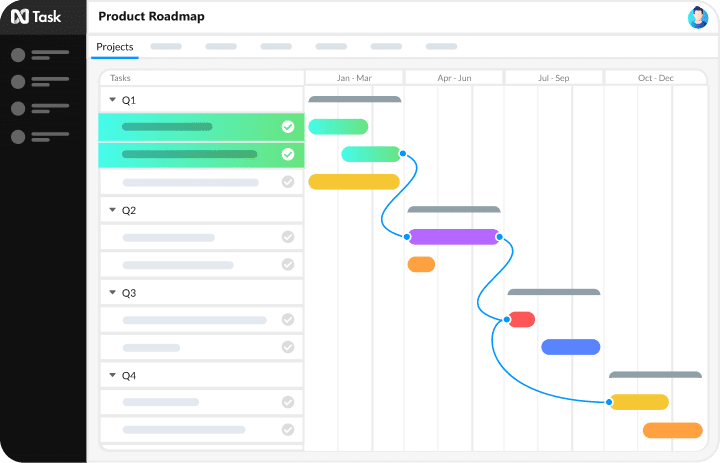
nTask is an online project management tool designed specifically for streamlining and simplifying agile workflows within any organization, whether they’re already utilizing agility or transitioning towards one.
With integrated Kanban boards, users can visualize their progress across multiple activities while automating recurring tasks, such as assigning resources accordingly whenever required.
These automated systems help save time spent manually managing workflows while offering insights into resource availability upgrades (completed assignments per hour), enabling better use of staff services when there are too many applications being managed simultaneously.
Additionally, nTask offers intuitive dashboards that provide up-to-date analysis about current projects, allowing users to generate detailed reports within minutes versus compiling extensive spreadsheets manually over long periods.
On top of that, users get access to powerful interactive Gantt Charts with richly customizable templates, setting milestones & timeline goals, combined with unparalleled drag & drop capabilities, simplifying creating descriptions and estimates, tracking performances, and improving overall efficiency no matter your background knowledge levels.
Lastly, comprehensive analytics permit managers to review performance history, anticipate issues early, intervene proactively, provide solutions quickly, avoid disruptions, earn customer trust, and add visibility across the organization.
Agile Project Management
Using nTask!

Conclusion
Creating and implementing an Agile workflow seems quite daunting at first but it never needs to be that difficult. Just follow everything that you read in this article and you will emerge victorious in your quest to make the perfect product using Agile as your savior.
FAQ’s
What is an agile workflow cycle?
What are the phases of agile development?
Concept and Requirement:
Identifying project goals, user needs, and prioritizing features.
Design:
Creating mockups, prototypes, and architectural plans for the software.
Development: Writing code and building the software components.
Integration and Testing:
Combining software components, identifying bugs, and ensuring quality.
Implementation and Deployment:
Launching the software to users and monitoring its performance.
Review and Retirement:
Evaluating the software’s success, making improvements, and eventually retiring the product when it is no longer needed.
Throughout each phase, stakeholder collaboration and continuous improvement are emphasized to ensure optimal results.
What are the advantages of agile workflow?
Greater flexibility:
Agile workflows allow teams to adapt to changes quickly and efficiently, making it easier to pivot strategies without disrupting the overall project flow.
Enhanced collaboration:
Agile methodologies promote open communication and collaboration between team members and stakeholders, leading to better decision-making and higher quality outcomes.
Continuous improvement:
By incorporating iterative development and regular feedback, agile workflows drive ongoing improvement in both processes and end products.
Improved customer satisfaction:
Agile workflows involve customers throughout the development process, ensuring their needs are met and fostering higher levels of satisfaction.

